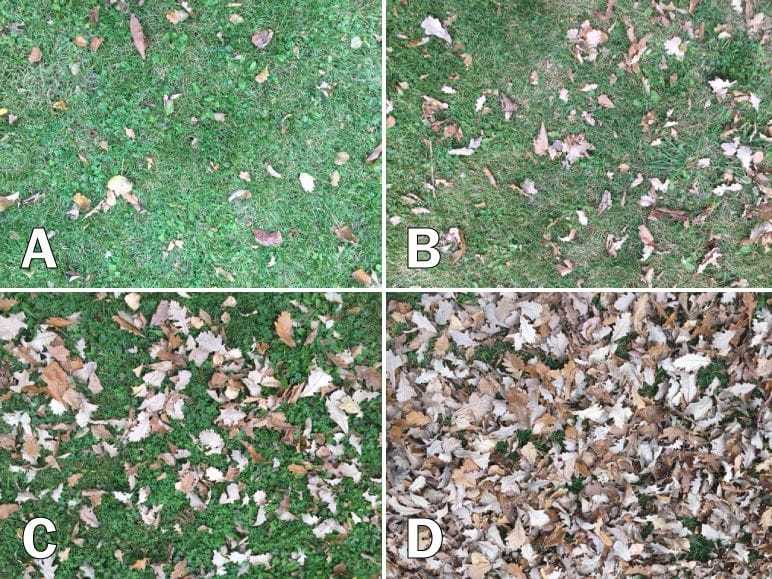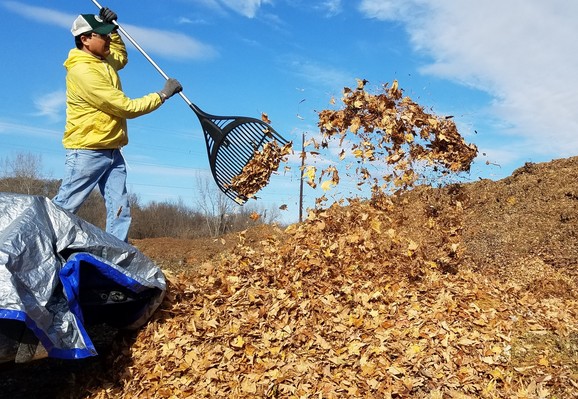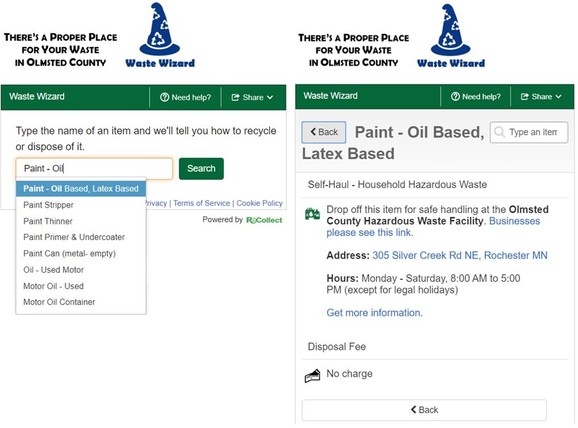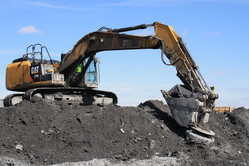|
Article I: Bag Your Rake and Mulch Your Leaves!
Article II: Help Prevent the Spread of Jumping Worms
Article III: The Waste Wizard Gets a Makeover
Article IV: Kalmar Landfill Plans Ash Cell Modification
Article V: Last Call for Environmental Achievement Award Nominations
Article VI: Disposal Discussion: Reuse Center at the Hazardous Waste Facility
Bag Your Rake and Mulch Your Leaves!

Autumn has arrived! With it, comes cool evenings, an assortment of pumpkin-spiced products, and for many residents, weekend afternoons filled with raking. If you find yourself dreading the impending leaf-drop, consider mulching your leaves to save time and energy.
Mulching leaves (with a mower) provides your lawn and soil with a great source of nutrients and organic matter, according to Sam Bauer—a turfgrass researcher formerly with the University of Minnesota. Bauer also states that "some leaf types have been shown to reduce weed seed germination when mulched into a lawn canopy (maple)."
While the benefits of mulching leaves are well-documented, Bauer explains that effective mulching requires more frequent mowing in the fall, and possibly several passes with your mower to sufficiently mulch the leaves. This is important, as excessive leaf matter can inhibit the growth of your grass. For more information from Bauer, check out the blog he wrote for the U of M on this topic.
|
Mulching Instructional Grid
The mulching grid below was featured in a 2016 Washington Post Article (Stop Raking Your Leaves) by Christopher Ingraham. The corresponding instructions were provided by Sam Bauer.
A. You could allow this many leaves to cover your lawn over winter, but they can
be easily mulched before that.
B. This would be an easy amount to mulch.
C. This level could be mulched with a good mower. Consider mulching blades and
close your mower’s side discharge.
D. This is too many leaves to mulch all at once. Consider removing 25% - 50% and
mulching the rest. Or mulch first and rake up the excess.
 Leaf Mulhcing Instructions; photo credit: Christopher Ingraham
When Your Lawn Is Covered in Leaves
If your yard looks like quadrant "D" in the grid above, mulching will only go so far. Excess leaves can be raked and composted at home. The Minnesota Pollution Control Agency and the University of Minnesota Extension have great resources to help you get started.
If mulching and composting at home are not options, you can bring leaves to the Olmsted County Compost Site any day of the week during daylight hours. There is no fee to dispose of yard waste, however, the site does accept donations (via drop-boxes) to help offset the cost of operations.
 A resident drops off leaves at the Olmsted County Compost Site; photo credit: Anthony Wittmer
Help Prevent the Spread of Jumping Worms
Jumping Worms are an invasive species of earthworm that are spreading throughout the Midwest. These worms look like other earthworms but when disturbed, they thrash erratically (jump) and move in an "S" pattern like a snake.
Jumping Worms live near the soil surface in debris and leaf litter. They feast on mulch and strip vital nutrients from the topsoil. This kills plants and increases erosion. Jumping worms have been spotted on the outer edges of the Olmsted County Compost Site. To date, Jumping Worms have not been confirmed in the finished compost available at the Compost Site.
Olmsted County operates the Compost Site in accordance with regulations set forth by the Minnesota Pollution Control Agency. The piles of decomposing yard waste routinely reach temperatures in excess of 130°F which is hot enough to kill a variety of undesirable weed seeds and Jumping Worm cocoons. However, the County does not guarantee the compost is free from all substances which may be harmful to plants, animals, and humans.
Precautions for residents dropping off yard waste
• Arrive clean and leave clean - clear soil and debris from vehicles, equipment, and personal gear before moving to and from a work or recreational area; they might contain Jumping Worm cocoons.
• Check your yard waste before bringing it to the Compost Site.
Precautions for compost customers
• Inspect the compost for Jumping Worms as you load it into your vehicle/trailer.
• At home, inspect the compost as you are spreading it around your lawn or garden.
• If you find Jumping Worms at home, destroy them by collecting them in a plastic container (with a lid) or zipper-lock bag and throw them in the trash. Notify Laura.Vanriper@state.mn.us at the Minnesota Department of Natural Resources.
If you find Jumping Worms in Olmsted County compost, call 507-328-7070 or email
pwservice@co.olmsted.mn.us. Reducing the adult population will eventually reduce the number of egg-carrying cocoons in the landscape.
For more information, including ways to identify Jumping Worms, visit the Minnesota Department of Natural Resources' website.
 Photo by Josef Gorres, University of Vermont
Waste Wizard Gets a Makeover

It can be difficult to remember the proper place for your waste in Olmsted County. Fortunately, you don't have to! For years, the Waste Wizard, at olmstedwaste.com, has provided disposal instructions for over 500 types of waste!
Do you need get rid of old appliances, furniture, or even hazardous materials but you're not sure where to go? Just type your items into the Waste Wizard and you'll learn where to take your items, when to drop them off, and if there's a fee.
If you regularly use this wizard, you'll notice a small change in its appearance. The logo has been updated in collaboration with other counties in Southeastern, MN.
The Waste Wizard is for households, businesses, should email pwservice@co.olmsted.mn.us with questions.
|

Kalmar Landfill Plans Ash Cell Modification

Olmsted County operates the Kalmar Landfill located approximately four miles west of Rochester, MN. This facility includes a double-lined municipal solid waste (MSW) combustor ash landfill that is the depository for ash from the Olmsted Waste-to-Energy Facility (OWEF) and Mayo Medical Waste Incinerator. The County is proposing to modify the ash landfill cell design by revising the base liner grade of two already permitted, but unconstructed disposal cells, and increase the future landfill capacity by permitting three disposal cells over 4.8 acres.
These modifications will add additional disposal-air-space and extend the landfill life expectancy from 2032 to 2064 while maintaining the existing high standards of environmental protection.
|
 A bulldozer spreading ash at the Kalmar Landfill; photo credit: Anthony Wittmer
One Spot for a Landfill
Much of the bedrock in Olmsted County consists of Karst. In a Karst geology, surface water can drain into underlying aquifers quickly. This is due to fractures, sinkholes, and caves in the underlying soils and rock.
The colors on the map below depict areas of ground water sensitivity. The green section of the map represents the only suitable spot for a landfill in Olmsted County. Here, a natural clay barrier ranging from 30' to 100' provides the foundation for the Kalmar Landfill (outlined in yellow).
 Sensitivity Of The Ground-Water System To Pollution
Protecting the Environment
The landfill’s protective layers resemble the layers of a cake. The 5.5 feet of compacted engineered clay, two high-density plastic liners, a granular sand drainage layer, and leachate collection system separate OWEF ash from the underlying soil (which is native clay).

Last Call for Environmental Achievement Award Nominations

The Olmsted County Environmental Commission and Rochester Public Utilities (RPU) are seeking nominations for the 2019 Environmental Achievement Awards. The awards honor individuals, organizations, schools, and businesses that have made a significant environmental contribution over the past year in Rochester/Olmsted County.
Award categories include climate change, education, renewables, sustainable food production, conservation, energy, water, and "other."
Since 1992, the awards have recognized the positive environmental impact of over 100 Olmsted County and Rochester community members and groups.
To submit a nomination or to see last year's award winners, visit our website. Completed nominations are due by Friday, October 4, 2019, to Anthony Wittmer—wittmer.anthony@co.olmsted.mn.us.
Disposal Discussion: Reuse Center at the Hazardous Waste Facility
The Olmsted County Hazardous Waste Facility provides a one-stop drop-off for a variety of poisonous, flammable, and corrosive products. In 2018, the facility served over 18,000 households and processed over 190 tons of hazardous materials!
Approximately 40% of the materials brought to the HWF are reusable. These items are given a second life in the Reuse Center. Items commonly featured in the Reuse Center include:
Automotive Products (waxes, cleaners, fuel additives, etc.)
Aerosols
Cleaning Products
Paints
Paint Solvents
Varnishes
Wood Stains
All products it the Reuse Center are free for the taking. However, there is no guarantee these products will be available. Visitors are asked to limit the number of items they take to ten per day. The HWF and Reuse Center are located at 305 Silver Creek Road NE, Rochester, MN 55906. Both are open Monday though Saturday from 8:00 AM to 5:00 PM.
 Items available for pickup in the Reuse Center at the Olmsted County Hazardous Waste Facility; photo credit: Anthony Wittmer
|